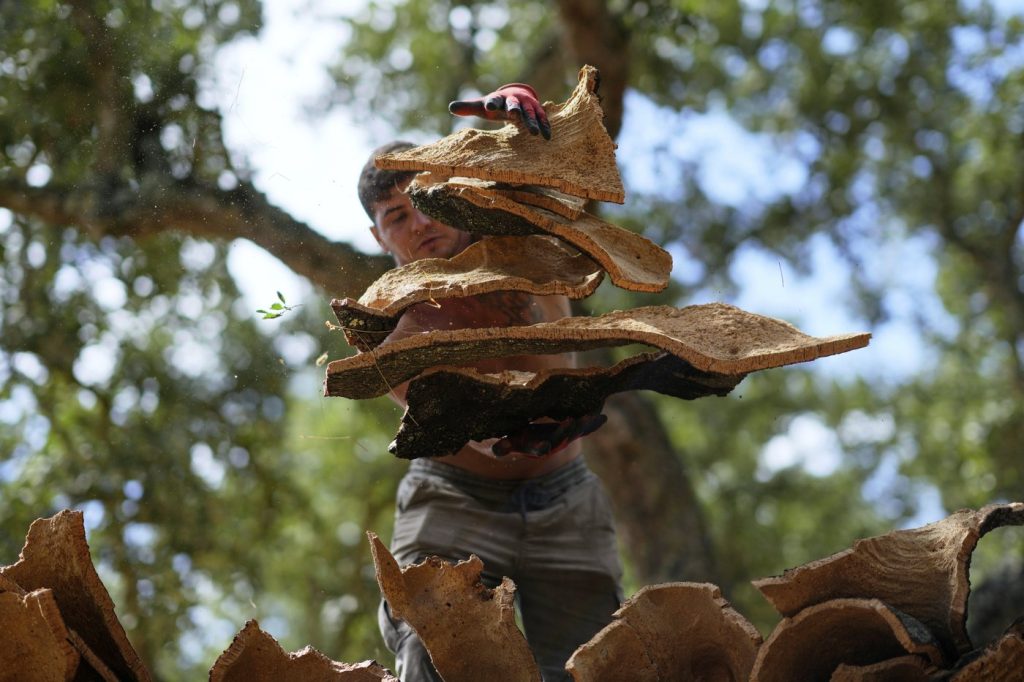RIO FRIO, Portugal (AP) - U.S. winemakers are celebrating a significant win: corks are exempt from tariffs. Cork, which is harvested from the spongy bark of the cork oak tree primarily found in the Mediterranean basin, enjoys this tariff exclusion thanks to a framework trade agreement between the United States and the European Union. As of September 1, cork joined the ranks of select items, such as airplanes and generic pharmaceuticals, that are exempt from the 15% U.S. tariff imposed on many EU products.
This exemption is crucial for Portugal, the world's largest cork producer, accounting for approximately 50% of global production. Portuguese diplomats worked diligently on both sides of the Atlantic to secure this exemption. Patrick Spencer, the executive director of the U.S.-based Natural Cork Council, notably traveled from Salem, Oregon, to Washington in June to advocate for cork's tariff reprieve. Similarly, the Wine Institute, which represents California vintners, supported this initiative.
Spencer expressed his delight when the summary of the U.S.-EU agreement released in August specifically mentioned cork. He remarked, "It was a great day in our neighborhood," proudly labeling himself a "cork dork."
As of now, it remains uncertain whether cork is an isolated case or if other natural products will enjoy similar exemptions in future trade agreements. Queries to the U.S. Department of Commerce and the White House regarding potential tariff exemptions went unanswered. Furthermore, the future of the tariffs, originally imposed by former President Donald Trump on imports from the EU's 27 member nations, is in limbo. A recent U.S. appeals court ruling stated that Trump lacked the authority to impose such sweeping tariffs, but these tariffs remain in effect as the administration appeals to the U.S. Supreme Court.
If the tariffs persist, the cork exemption might signal further exemptions for other items. U.S. Commerce Secretary Howard Lutnick hinted in a July interview with CNBC that natural products, such as mangoes and cocoa, could also be free from tariffs.
The United States stands as the second-largest market for Portuguese cork, following France. In 2023, the U.S. imported $241 million worth of cork from Portugal, primarily in the form of stoppers for wine, spirits, olive oil, honey, and various other liquids. Approximately 70% of these imports were for wine closures, as stated by the Natural Cork Council.
Cork has diverse uses beyond wine. NASA and SpaceX have utilized cork for thermal protection in rockets, and cork crumbs are used in sports fields and as shock absorbers in airport runways. Despite the similar climate in California to that of the Mediterranean, the U.S. has never developed a cork industry. An attempt to establish a cork production operation during World War II resulted in around 500 remaining cork oaks on the University of California, Davis campus, but the initiative did not succeed after the war due to the long maturation time required for cork oak trees.
Antonio Amorim, the chairman and CEO of Corticeira Amorim, one of the world's largest cork companies, noted, "Americans are not patient enough to wait for a tree that takes 25 years to give its first harvest." The specialized skill required for cork harvesting adds to the difficulty, as improper cutting can kill the tree. Consequently, cork harvesters are among the highest-paid agricultural workers in Europe.
Amorim's operations include over 20 million cork trees spread across 700,000 hectares (1.7 million acres) of woodland. At Herdade de Rio Frio, a farm located 40 kilometers (25 miles) southeast of Lisbon, workers can be observed harvesting cork in a time-honored manner. They gently pierce the bark to peel it off, ensuring they do not damage the trunk. This traditional method has been employed by the Portuguese for over 200 years.
The harvested cork is then transported to factories, where it is cut into strips for producing stoppers. After the trees are stripped, workers mark the trunks to indicate the year of harvest. The cork oaks at Herdade de Rio Frio, which can endure drought conditions and hot summers, were planted more than a century ago.
One of the reasons many U.S. winemakers have shifted back to cork stoppers is the sustainable harvesting process and the biodegradability of cork. After initially experimenting with aluminum, plastic, and glass closures, the percentage of premium U.S. wines using cork stoppers increased from 53% in 2010 to 64.5% in 2022, according to the Natural Cork Council.
While cork taint, caused by a fungus in natural corks, posed significant challenges in the 1990s, leading many winemakers to opt for alternative closures, this issue has been largely mitigated in recent years. New technologies have also emerged, enabling screw caps to mimic the oxygen transfer properties of cork over time. Many wineries, including Trump Winery in Virginia, now use both screw caps and natural corks, with screw caps being favored for wines intended for immediate consumption, while cork remains the standard for aging wines.
Chemist Andrew Waterhouse from the University of California, Davis, stated, "If you say, ‘Has this wine aged properly?’ what you mean is, ‘Was it in a glass bottle with a cork seal in a cool cellar?’ Under any other conditions, it didn’t age the same. We’re always trapped by history."










